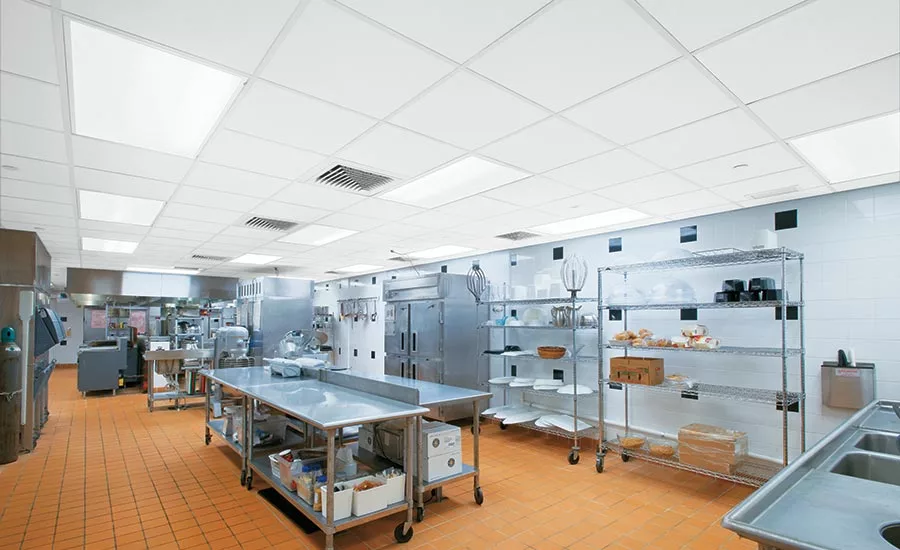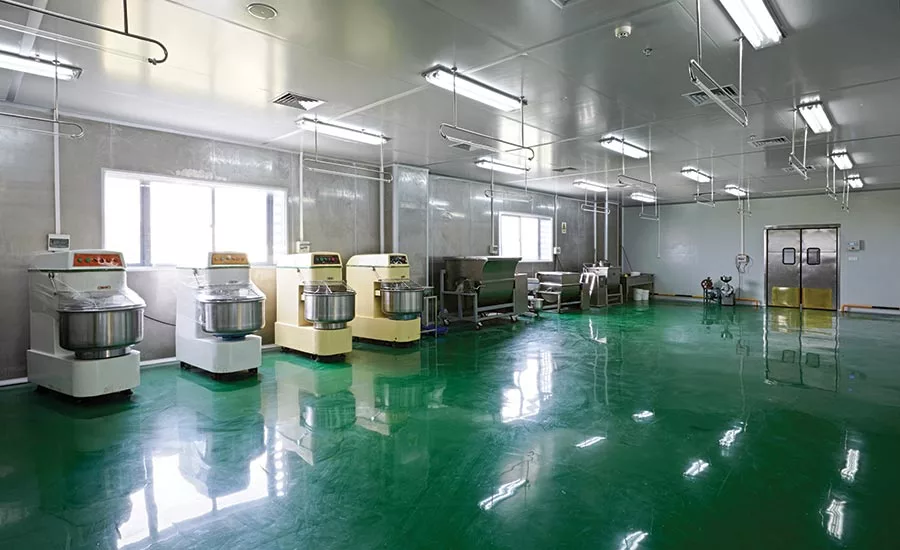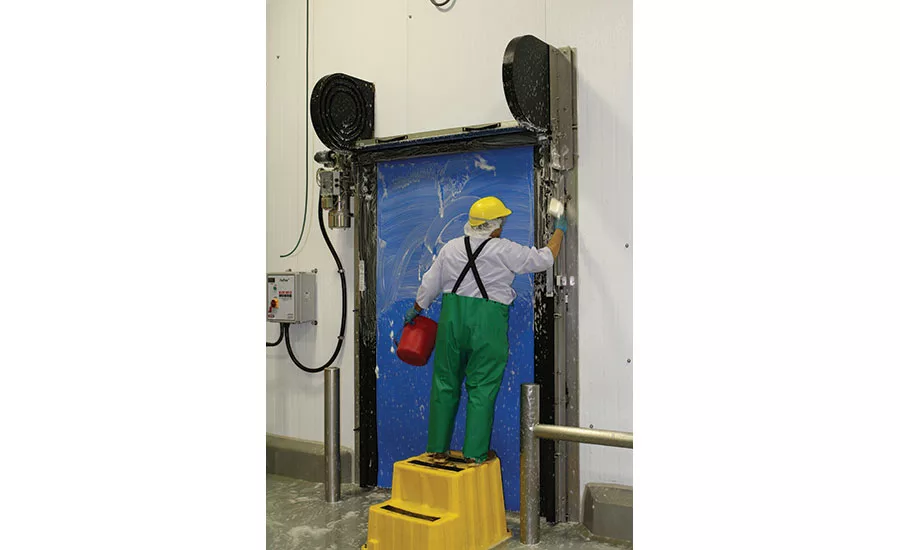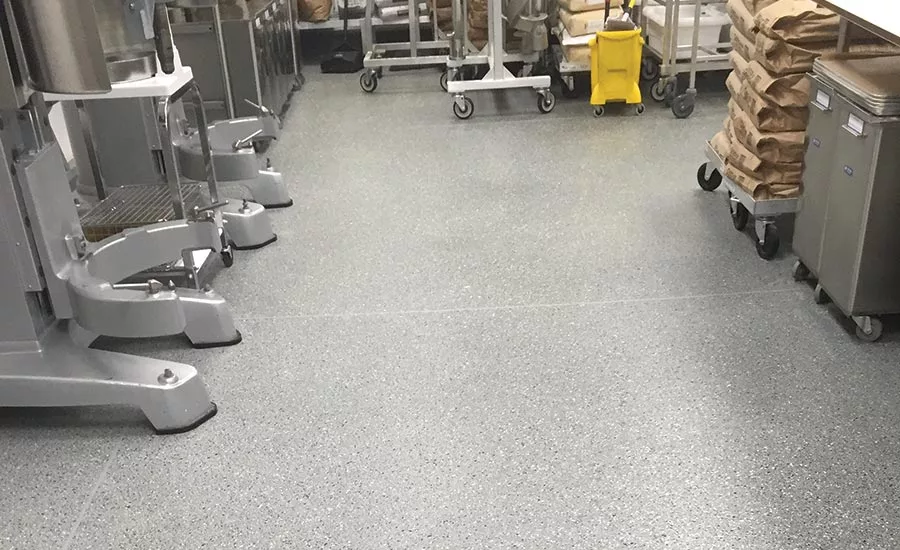Tech Update
How food processors can choose the right floors, doors and ceilings
From floors to doors to ceilings, processors can find the right solutions for their specific needs

Selecting the right ceiling material for food processing applications requires considering acoustics, bacterial and microbial growth resistance, and cleanability.
Photo courtesy of Armstrong Ceilings

Depending on where flooring material is needed in a plant, its properties, texture and interactions with cleaning materials are all variables that must be considered.
Photo courtesy of Sherwin-Williams

Selecting doors for a food processing plant involves a number of decisions, including door opening and closing speed, resistance to microbial growth and corrosion, and cleanability.
Photo courtesy of RiteHite

Durability, cleanability and slip/fall resistance are among the considerations for flooring materials in a food processing plant.
Photo courtesy of Sherwin-Williams
If there’s one universal answer to how processors can best evaluate and choose floors, doors and ceilings, it is this: There is no universal answer.
Environmental demands, allergen control, acoustics, cleaning and production needs all help define what you need from these products and shape the evaluation process for identifying and installing the right ones. Where this gets really tricky is coming to the understanding that even on the production floor, there’s no one-size-fits-all solution. Dry areas will have different demands than wet areas; hot areas will have different demands than cold areas.
“We look at a food plant as a bunch of little microenvironments,” says Casey Ball, regional manager of flooring, Sherwin-Williams, listing off production, breakrooms and storage as areas of a plant that would have different demands. “What we use in a production area would be a urethane concrete. Maybe you don’t use that in a breakroom, because it’s not going to see the changes in temperature or the heavy-duty cleaning.”
The same thought process applies to doors and ceilings as well, even though the same criteria do not apply to them: What specific needs does this door/floor/ceiling have to meet, and how do we ensure it meets those needs?
In the case of food processing, some of the most common needs are hygiene and worker safety, with acoustics and sustainability playing smaller roles as well. All of those needs can be met if they are properly identified and accounted for in the planning stages.
Slipping into a new floor
While floors, doors and ceilings all share a few common concerns, floors have an additional area of focus when it comes to worker safety. Slip hazards are at the top of the list of flooring concerns, especially in areas that are often washed down or are damp environments.
“Regularly washed-down floors never really dry,” says Sophia Daukus, marketing communications manager, Florock.
The floor itself is most likely going to be concrete. Uncovered concrete is not only a disaster waiting to happen, it also runs afoul of USDA regulations. Concrete is porous, so it will absorb all kinds of nasty things over time, which creates both an unsafe work environment and the potential for contamination.
These challenges are handled with a coating, which can be one of a number of different materials based on the exact demands of a space. A production area floor is most likely to be covered by a resin-rich material because of its ability to hold up under regular washdowns, temperature changes and thermal shock. Older epoxy coatings can offer some of the same benefits, but run the risk of developing microscopic cracks under heavy impacts, such as a drum being dropped. Over time, water can get into those cracks, mix with the highly alkaline concrete and begin eating away at the coating from underneath. Consequently, urethane mortar is becoming more commonly used, since it holds up better against the possibility of cracking and can stand up to repeated washdowns.
“No other concrete coating can match the track record of urethane mortar against the near-constant cleaning taking place in processing plants,” says Daukus. “In addition, urethane mortar systems can be customized in terms of slip resistance, antimicrobial protection, thickness and other characteristics to achieve optimal solutions for specific plant conditions.”
Slip resistance is one of the top concerns for flooring in a food processing plant. Washdowns, damp production areas and spillage of ingredients and materials can all turn a smooth floor into an ice rink. The solution is to make sure that your floors aren’t actually smooth, because adding texture offers better grip and improved safety. But adding texture also makes floors harder to clean. Think of it this way: While it may be a lot easier to mop a linoleum kitchen floor than a concrete sidewalk, it’s also a lot easier to slip on the linoleum if you’re just wearing socks.
To solve this, the covering needs some sort of aggregate, says Ball. Making that decision has its own group of factors.
“Aluminum oxide is more expensive, but it’s more angular, so you get more non-skid with aluminum oxide than you do with sand, and it lasts longer,” he says. “But sometimes, it can be more difficult to clean. So, you can mix it with sand to get a little benefit with sand from a cost perspective and a cleanability perspective, as opposed to using all aluminum oxide.”
The good news about making these kinds of decisions is that the texture is highly customizable depending on your exact needs. That means processors can be specific in what they want their flooring to be in certain parts of the plant based on potential slip/fall hazards. But it also means that processors need to be sure they’re evaluating the texture properly, says Bharath Singh, project director, Gray Construction.
“It is not only important for the processors to select the appropriate level of grit for the flooring systems, but to also check it against the type of footwear that is expected to be used,” says Singh. “Processors should not forget to check the floors against the tires used by pallet jacks and forklifts that are to be used in the areas.”
When you move into other areas of the plant, your flooring demands will change, which means the materials needed will change. Slip/fall hazards may be the top priority in one part of the plant, while static electricity dissipation is important in another area. The type of flooring material will be very different depending on whether the area is used for chemical or dry material storage, or if it is for freezing and cooling.
“Specific site conditions and traffic patterns, plus details of chemical and temperature exposure, all play important roles in flooring selection,” says Daukus.
She points out that while general food production areas can be well served by a urethane mortar flooring, areas where chemicals are stored need a vinyl ester flooring material. If it’s a powder storage area, then a floor that is static dissipative helps remove static discharge to cut down on explosion risks.
As below, so above
Ceiling decisions share a number of concerns with floors, such as cleanability, durability and contamination control. And, like flooring, the same ceiling doesn’t work in every place in the production plant.
The best way to start your evaluation process for ceilings is by asking what will be in the space and what its needs and challenges are. If it’s a room that processes dry materials, that will have one set of demands. Wet materials are another, freezing areas are another, and so on.
“The most important part in evaluating the best ceiling for a space is to understand how the space will be used, who will occupy the space and what requirements may be in place by the owner,” says Anita L. Snader, environmental sustainability manager, Armstrong Ceilings. “In selecting a ceiling, there are many performance features that are designed to create the right space, including acoustics, sustainability, cleanability, durability and light reflectance.”
As is the case with doors and flooring, there is no universal food processing plant ceiling product on the market. The needs of the space and the people in it will shape what you want and need from your ceilings.
“The areas that typically get evaluated for ceilings in production areas also have hygienic, temperature and sanitation requirements,” says Singh. “These are most easily met by installing different types of ceilings to contain process and utility in the same footprint, but at separate levels.
“However, as you move into cold storage areas, product is typically covered, sealed, boxed or palletized. The hygienic level is usually lower in these areas, with volume being the main goal within a footprint. In an office/welfare area, high-moisture areas, such as locker rooms, employee showers/toilets, will be better served with using a highly cleanable surface as compared to typical office ceilings.”
One concern that needs to be top of mind in most production areas is bacterial and microbial growth. Using the wrong kind of ceiling can lead to mold and mildew gaining a foothold, which will most likely require replacing the ceiling or at least part of it. Mold- and mildew-resistant ceilings can help curtail that and can make a big difference in wet or damp areas.
“In selecting ceilings for certain conditions, it is important to understand what performance is needed, how the building will be operated at all times, and then select the right ceiling with the correct humidity properties,” says Snader.
One area that sets ceilings apart from doors and flooring is the role they can play in managing acoustics. Production areas tend to be loud, and ceilings can help manage that sound. By absorbing, redirecting or blocking it, ceilings can help reduce the decibel level in workspaces and on the production floor overall.
“Ceilings are designed to achieve absorption and blocking in different open and closed plan environments,” says Snader. “Acoustical performance is also dependent on what other acoustical treatment is in the space, such as on the walls, or if the plenum is open or has wall-to-wall ceilings. Ceilings can also provide a retrofit option to solve existing environments that are too noisy.”
Open (and shut) possibilities
While doors are the smallest item on the list of doors, floors and ceilings, that doesn’t mean they play a less important role or are easier to evaluate and use. Due to the variety of different doors needed in a processing plant, these decisions can be complex, especially when considering the role of each door.
“With the hygienic and temperature requirements of processing activities, doors play a vital role in keeping these levels balanced for the allocated systems,” says Singh. “This not only improves the efficiencies of the building itself with lower refrigeration demands/costs and less condensation, but it also improves the yields and quality of the product.”
There’s one important thing to remember when it comes to specifying doors. They don’t claim to be “something-proof.” While certain doors may do a very good job of blocking sound, bacterial growth or even bullets, they most likely won’t be able to stop everything, says Howard Schrier, director of specialty products, ASSA ABLOY Door Group.
“If they are bacteria-resistant or corrosion-resistant, the doors we are providing are resisting as much bacteria or corrosion as possible,” says Schrier. “These doors are not ‘proof;’ they are resistant to whatever is being specified.”
With that in mind, processors can evaluate what levels of resistance they need in different areas of the plant. While stainless steel is going to offer improved resistance to corrosion, it might not be needed in an area that is dry processing. But while that door may not need to be as corrosion resistant, it is still going to need to be cleanable, says Jon Schumacher, director of marketing, Rite-Hite Doors.
“More and more companies are understanding that deep cleaning is needed, where in the past, it was maybe only the large multinational companies that took it seriously,” says Schumacher.
For example, Schumacher says a major retailer he works with has to audit 100 percent of its suppliers to ensure they’re cleaning to a high enough standard.
Schumacher paraphrases the words of the retailer, “We won’t sell any product from any company unless we send in our own auditors to make sure this company has a good understanding of what deep cleaning is.”
Cleaning is one important consideration for doors. Allergen control and cross-contamination are others. While they may not play as large a role in those tasks as things such as air pressurization, having doors that are suited to supporting allergen control efforts certainly helps.
“Some facilities choose automatic doors when open product is moving to eliminate any potential for contaminated product,” says Singh. “Mechanical doors can be used in conjunction with air doors appropriately at critical locations to offer a high degree of air management control.”
This air management helps ensure that particles and dust are staying where they’re supposed to and not traveling into production areas. Sealing and/or automatic doors can help ensure that air isn’t getting out of where it’s supposed to be and, thereby, cut down on the possibility of cross-contamination.
From top to bottom
While there’s no universal answer to what processors need in floors, doors and ceilings, there are some basic guidelines that can help inform all of their choices in those categories.
The most important is doing a thorough, objective analysis of what exactly you need to be doing in a particular space, how it’s going to be done and who’s going to do it. Once you have done that, then you can build on it to specify the exact things you need.
For more information:
Armstrong Ceilings, www.armstrongceilings.com
Florock, www.florock.net
Gray Construction, www.gray.com/projects/food-and-beverage-plant-construction
Rite-Hite Doors, www.ritehite.com
ASSA ABLOY, www.assaabloy.com
Sherwin-Williams, www.sherwinwilliams.com
Looking for a reprint of this article?
From high-res PDFs to custom plaques, order your copy today!







